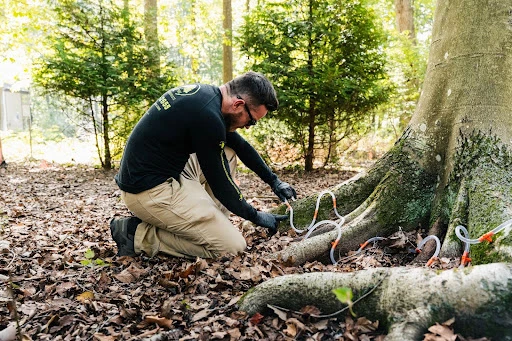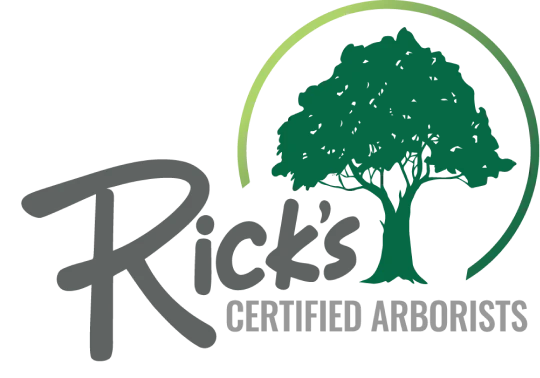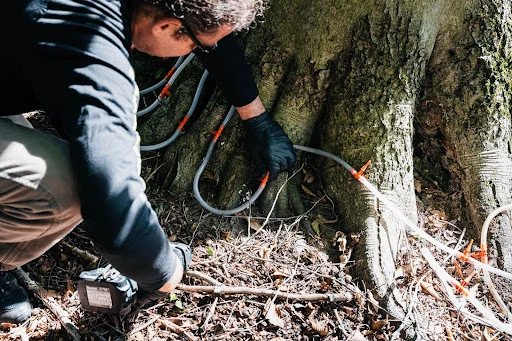Listen up, tree lovers! You need to know about Beech Leaf Disease. This insidious ecological threat was first detected in Ohio around 2012 and has been rapidly spreading throughout the northeastern United States and parts of Canada ever since. It doesn’t discriminate—attacking American Beech trees, European Beech trees, and Oriental Beech trees alike.
Our team at Rick’s Certified Arborists has treated this condition firsthand with targeted, long-lasting remedies. We’ve seen how, left unchecked, once-beautiful trees get destroyed in record time, so we want to arm our community with the information they need to spot the signs and reach out to us right away for top-notch Tree Care Services, including Beech Leaf Disease Treatment and other insect and disease control solutions.
What is Beech Leaf Disease, & Why Is It a Threat to Trees?
Beech Leaf Disease (BLD) is a serious and fast-spreading issue that’s putting Beech Trees at risk across North America. It starts with strange, dark bands on the leaves, eventually causing them to curl and wither, weakening the tree over time and potentially killing it. Scientists have traced the cause to a tiny nematode, Litylenchus Crenatae Mccannii, which invades the leaves and buds, messing with the tree’s ability to produce energy through photosynthesis.
BLD spreads through contaminated plant material, soil, or tools and might even hitch a ride via wind, water, or wildlife. As Beech trees are a key part of forest ecosystems, the rapid spread of BLD is raising alarms for conservationists and nature lovers alike.
The Dangers of DIY Treatment Attempts
Attempting to treat infected Beech trees without professional assistance often leads to unintended consequences that can exacerbate the problem. Unproven remedies and DIY solutions frequently fail to effectively eliminate nematodes, the primary culprits behind many infections, and can even compromise the tree’s overall health. In some cases, these approaches might inadvertently spread the nematodes to nearby trees, further endangering your landscape.
Additionally, improper application of treatments can disrupt the delicate balance of the soil, harming beneficial microorganisms that play a critical role in maintaining tree vitality. Without the guidance of a trained Arborist or Plant Health Specialist, what starts as a manageable issue can quickly spiral into a widespread problem, putting the health of your entire landscape at risk. Seeking professional care ensures accurate diagnosis, effective treatment, and long-term protection for your trees.
Benefits of Working With Professional Arborists for BLD

Certified Arborists bring the know-how to tackle Beech Leaf Disease with precision and care. Their specialized training ensures treatments are customized to each tree’s unique needs, delivering targeted, effective results. With access to cutting-edge nematocidal solutions, they help safeguard your tree canopy and curb the disease’s spread.
Common Beech Leaf Disease Treatments
Treatment plans vary depending on the severity of the disease and the type of tree. Methods like Foliar Sprays, Trunk Injections, and Soil Treatments are commonly used to stop the spread of BLD. Each technique targets the underlying causes while strengthening the tree’s defenses against future outbreaks.
Foliar Sprays
Foliar Sprays coat the leaves with a protective layer designed to combat harmful organisms, including the microscopic worms linked to Beech Leaf Disease (BLD). While this treatment can be effective for smaller Beech trees, it presents practical limitations for larger trees due to the difficulty of reaching mature canopies. Additionally, environmental concerns and the need for multiple applications per year can make this approach less sustainable. When used appropriately, however, Foliar Sprays can help manage BLD infections in accessible areas.
Trunk Injections
Trunk Injections provide a direct way to deliver treatment to infected trees. The solution moves through the tree’s vascular system, targeting nematodes deep within. This method is ideal for mature Beech trees and those already showing significant symptoms. Arborists use specialized tools to administer injections, ensuring precision and minimizing damage to the tree trunk or other surrounding plant life.
Soil Injections
Soil Injections target the root zone of infected trees, introducing Phosphite or Phosphoric Acid to help combat the effects of Beech Leaf Disease (BLD). These treatments work to restore essential nutrients depleted over time and strengthen the tree’s natural defenses, promoting long-term resilience. Research recommends applying these treatments 2-3 times per year for optimal results. Arborists customize the application based on soil conditions and tree size, providing an efficient and sustainable solution for BLD management.
Prevent Future BLD With Expert Inspections
Regular tree inspections are key to staying ahead of Beech Leaf Disease and similar threats. Scheduling these checkups at least once a year—or more often in vulnerable areas—lets our experts catch issues like Beech Bark Disease, Beech Anthracnose, and more early on. With cutting-edge tools and techniques, we spot the first signs of trouble and take action before the damage escalates. These proactive evaluations help maintain the health of your trees, keep your outdoor space thriving, and ensure your greenery stays vibrant for years to come.
For the Best BLD Treatment, Call Rick’s
Protecting your trees demands expert intervention. Rick’s Certified Arborists stands ready to safeguard your landscape against Beech Leaf Disease’s devastating effects. Our team combines scientific knowledge with hands-on expertise, delivering unparalleled tree care solutions every time. Give us a call if you suspect BLD or any other tree-related issue, and see for yourself why we’ve become a trusted name in the West Chester, PA area.

